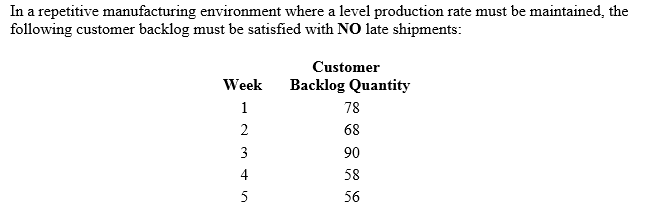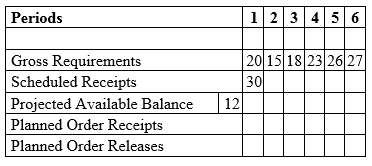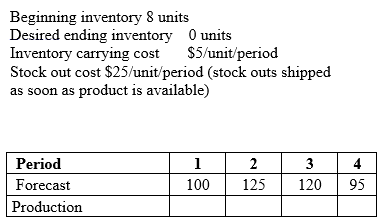Certified in Production and Inventory Management - Master Planning of Resources v6.0
Question 1
Capacity planning occurs at what stage of the Sales and Operations Planning (S&OP) process?
- A. Demand planning phase
- B. Supply planning phase
- C. Pre- SOP meeting
- D. Executive SOP meeting
Answer : B
Question 2
A forecasting method that responds slowly to changes in demand would be most appropriate when the historical demand pattern shows a major:
- A. seasonal component.
- B. random component.
- C. trend component.
- D. cyclical component.
Answer : B
Question 3
The resource profile approach to rough-cut capacity planning is desirable in the manufacture of parts with lengthy lead times because the approach:
- A. uses detailed data about time standards for each product at the key resources.
- B. assumes that all components are built in the same period as the end item.
- C. considers the historical portion of the total plant time required.
- D. time phases labor requirements.
Answer : D
Question 4
In a make-to-stock environment, which of the following factors is a key determinant of inventory levels necessary to support customer demand?
- A. Capable-to-promise
- B. Available-to-promise
- C. Service costs
- D. Service level
Answer : D
Question 5
In the master scheduling process, customer orders are the only source of demand in periods:
- A. within the item lead time.
- B. before the demand time fence.
- C. between the demand and planning time fences.
- D. beyond the planning time fence.
Answer : B
Question 6
A Canadian-based company has a long-term contract with a US-based supplier. The
Canadian company has been experiencing short shipments and variations of the supply lead time with the US supplier for a few months. Which of the following is the most appropriate action for the master production scheduler in this situation?
- A. Ask the purchasing manager to work with the supplier to improve their shipping quantity accuracy and lead time stability.
- B. Ask the purchasing manager to terminate the contract with this supplier, and look for a better supplier.
- C. Apply safety stock and safety lead time while planning the master production schedule.
- D. Apply safety lead time according to the target service level while planning the master production schedule.
Answer : D
Question 7
Which of the following issues is most likely to lead to the use of a short-term, rather than long-term, forecasting process?
- A. How to respond to a competitor's test marketing of a new product
- B. How to configure the supply chain to support a new market segment
- C. Whether to outsource a capital-intensive subassembly process
- D. Whether to take a price-leadership or a product-differentiation posture
Answer : A
Question 8
A company wanting to maintain a high level of customer service at the lowest inventory carrying cost should place safety stock in:
- A. central and field warehouses.
- B. field warehouses.
- C. a central warehouse.
- D. customer's facilities.
Answer : C
Question 9
The question below is based on the following information:

Which of the following weekly production rates best supports these criteria?
- A. 70
- B. 78
- C. 80
- D. 90
Answer : C
Question 10
Production is being planned to emphasize the utilization of a critical and very expensive piece of capital equipment. Which of the following production planning strategies should be used?
- A. Chase
- B. Level
- C. Cost-based
- D. Combination
Answer : B
Question 11
The question below is based on the following distribution requirements plan:

Lead time is 1 week, lot size is 30, and safety stock is 0. Planned order releases would occur in which of the following sequences?
- A. Weeks 3, 4, 6
- B. Weeks 2, 3, 5
- C. Weeks 2, 3, 4
- D. Weeks 3, 4, 5
Answer : B
Question 12
Translation of a master production schedule directly into key resources results in a:
- A. production schedule.
- B. final assembly schedule.
- C. rough-cut capacity plan.
- D. bill of labor.
Answer : C
Question 13
The question below is based on the following information:

A company has chosen to execute a level production plan. What is the production rate per period?
- A. 108
- B. 110
- C. 112
- D. 125
Answer : A
Question 14
Which of the following goals is the primary outcome of distribution requirements planning?
- A. Accurately feed the gross requirements into the master production schedule
- B. Decouple the distribution plan from the production plan
- C. Deliver products in the quantities requested by the customer
- D. Maintain an appropriate inventory level at all locations
Answer : D
Question 15
The greatest risk of aggregating product families at too high of a level for sales and operations planning is that:
- A. it will be more difficult to reconcile the sales plans with the business plan.
- B. imbalances between the demand plan and resources may not be visible.
- C. the resource planning process will be more complicated.
- D. the sales forecasts will not be as accurate for the larger product families.
Answer : B